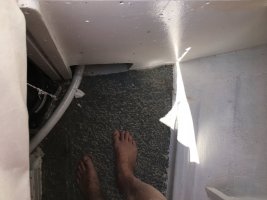Recently I've been working under the cockpit, with the usual issues. A few approaches and modifications have made things easier, or at least possible.
--Nonskid for slip issues. The footing in my cockpit lazarette hatch is bad. The hull slopes, stand in it and -- oops. After three years I greatly value the two square feet of nonskid paint I applied for better footing.

--Ratchet wrench for hose clamps. Two sizes covers all. When a hose clamp faces the wrong way, a screwdriver in confined spaces is awkward.
--Remove stuff for access. It took me a stubborn while to realize that, for any work in the bowels of the boat, it makes things much easier to clear the way first. On my model, the waterlift muffler and hose to the exhaust elbow come out pretty easily, which really clears the way to the stuffing box or engine. So does one end of a cockpit drain hose, if the hose is in the way. So does first removing all the gear down there (although I don't have any gear down there). The time spent is worth it, and once done a few times becomes routine.

Easy access with muffler removed from its platform
--Access ports. When a recurring job is easier from behind a bulkhead, an access port can be installed. Every subsequent owner will thank us.
Further ideas?
--Nonskid for slip issues. The footing in my cockpit lazarette hatch is bad. The hull slopes, stand in it and -- oops. After three years I greatly value the two square feet of nonskid paint I applied for better footing.

--Ratchet wrench for hose clamps. Two sizes covers all. When a hose clamp faces the wrong way, a screwdriver in confined spaces is awkward.
--Remove stuff for access. It took me a stubborn while to realize that, for any work in the bowels of the boat, it makes things much easier to clear the way first. On my model, the waterlift muffler and hose to the exhaust elbow come out pretty easily, which really clears the way to the stuffing box or engine. So does one end of a cockpit drain hose, if the hose is in the way. So does first removing all the gear down there (although I don't have any gear down there). The time spent is worth it, and once done a few times becomes routine.

Easy access with muffler removed from its platform
--Access ports. When a recurring job is easier from behind a bulkhead, an access port can be installed. Every subsequent owner will thank us.
Further ideas?
